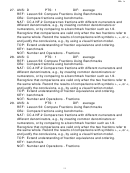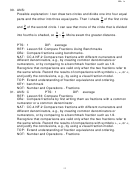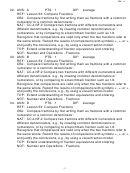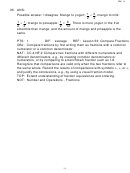Math Practice Test Page 20
ADVERTISEMENT
ID: A
12. ANS: C
PTS: 1
DIF: average
REF: Lesson 49: Simplest Form
OBJ: Write and identify equivalent fractions in simplest form.
NAT: CC.4.NF.1 Explain why a fraction a/b is equivalent to a fraction (n x
a)/(n x b) by using visual fraction models, with attention to how the number
and size of the parts differ even though the two fractions themselves are
the same size. Use the principle to recognize and generate equivalent
fractions.
TOP: Extend understanding of fraction equivalence and ordering.
KEY: equivalent fractions | numerator | denominator | factor | common
factor | simplest form
NOT: Number and Operations - Fractions
13. ANS: D
PTS: 1
DIF: average
REF: Lesson 49: Simplest Form
OBJ: Write and identify equivalent fractions in simplest form.
NAT: CC.4.NF.1 Explain why a fraction a/b is equivalent to a fraction (n x
a)/(n x b) by using visual fraction models, with attention to how the number
and size of the parts differ even though the two fractions themselves are
the same size. Use the principle to recognize and generate equivalent
fractions.
TOP: Extend understanding of fraction equivalence and ordering.
KEY: equivalent fractions | numerator | denominator | factor | common
factor | simplest form
NOT: Number and Operations - Fractions
14. ANS: B
PTS: 1
DIF: average
REF: Lesson 49: Simplest Form
OBJ: Write and identify equivalent fractions in simplest form.
NAT: CC.4.NF.1 Explain why a fraction a/b is equivalent to a fraction (n x
a)/(n x b) by using visual fraction models, with attention to how the number
and size of the parts differ even though the two fractions themselves are
the same size. Use the principle to recognize and generate equivalent
fractions.
TOP: Extend understanding of fraction equivalence and ordering.
KEY: equivalent fractions | numerator | denominator | factor | common
factor | simplest form
NOT: Number and Operations - Fractions
5
ADVERTISEMENT
0 votes
Related Articles
Related forms
Related Categories
Parent category: Education
 1
1 2
2 3
3 4
4 5
5 6
6 7
7 8
8 9
9 10
10 11
11 12
12 13
13 14
14 15
15 16
16 17
17 18
18 19
19 20
20 21
21 22
22 23
23 24
24 25
25 26
26 27
27 28
28 29
29








